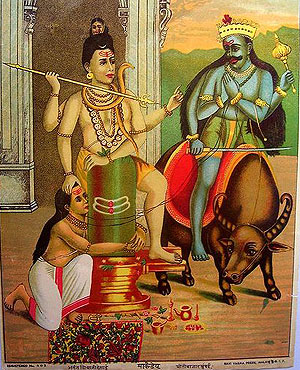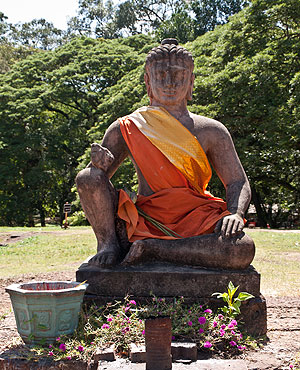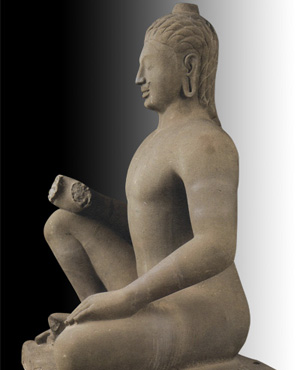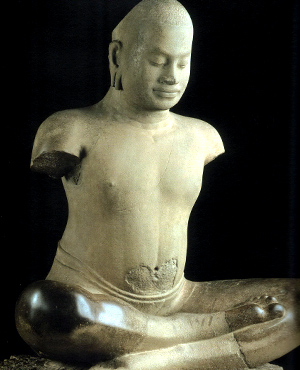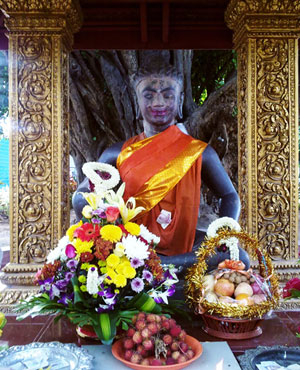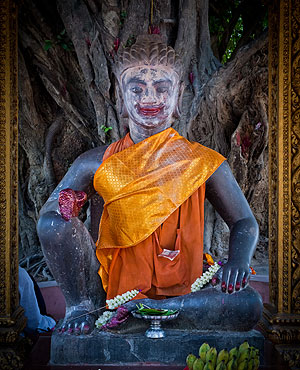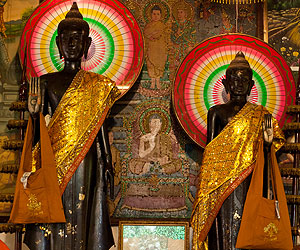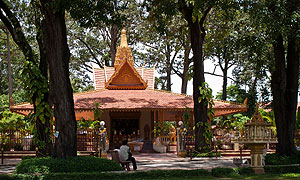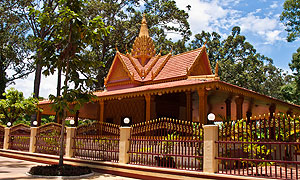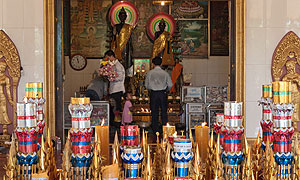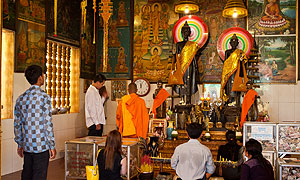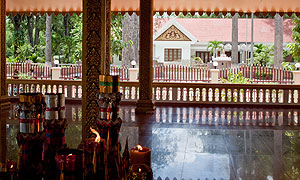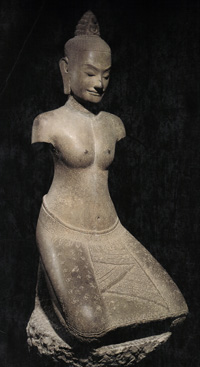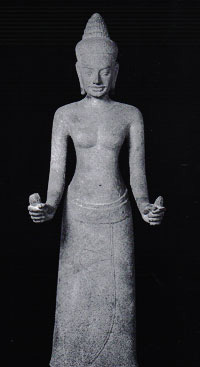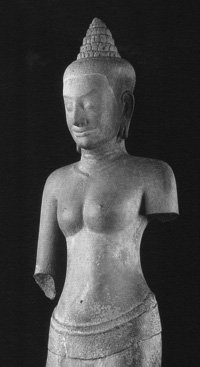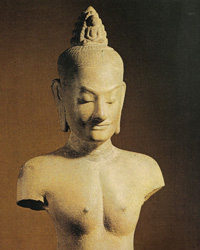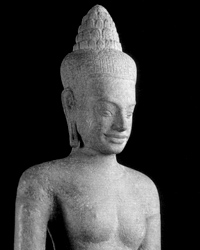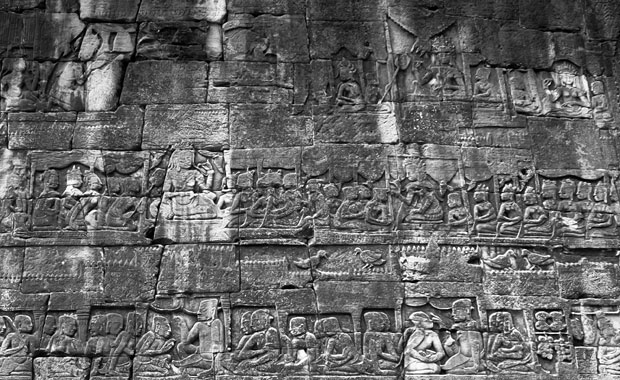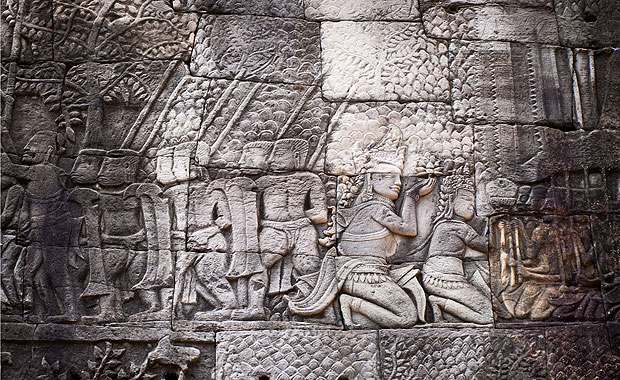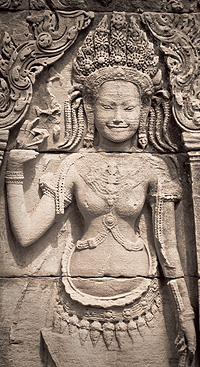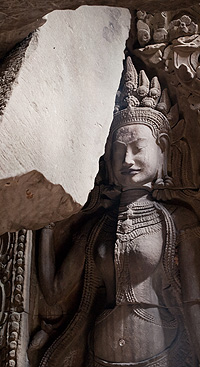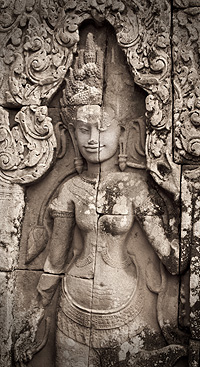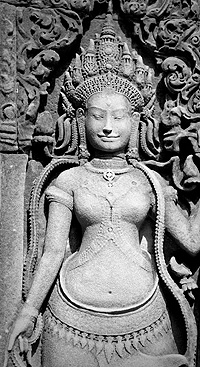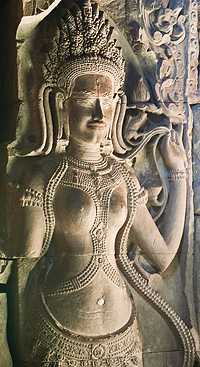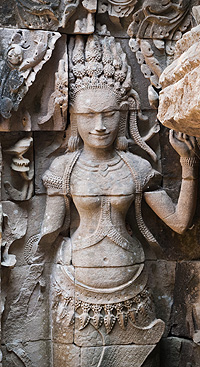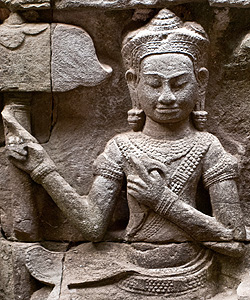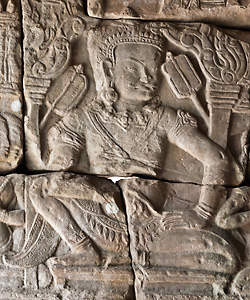— Rulers of the 12th Century Khmer Kingdom —
A Golden Legacy Providing Cambodia with Tourist Dollars
Important Facts About the 38-Year Reign (c. 1181-1220)
1. The king and his two queens came to power somewhere between their mid-40s to late-50s, during a time in the 12th century when most people died in their 40s. These late bloomers fully exercised their mature wisdom with clarity of focus about the direction in which they planned to take their new empire. Young Prince Jayavarman married first Princess Jayarajadevi. When he was crowned king, he also married Princess Indradevi, Jayarajadevi's older sister. Both spouses were recognized as queens in the royal portraitures in Bayon bas-reliefs. The royal triad eventually became a formidable team that their enemies sought to extirpate their influence after their deaths. However, the populace never forgot their endearing social deeds that survived in folktales. (2012 update: ALL new facts released in book: "The Ancient Secrets of a Royal Triad: DECODED")
2. Angkor became the largest metropolis with a population of one million people in the 12th century. During their reign, the king and his two queens innovated various social programs that realized the constructions of 102 hospitals, 121 rest stops[*], and numerous temples including:
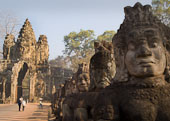




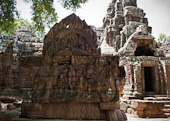
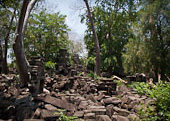


Srah Srang, Preah Khan of Kompong Svay, Ta Nei, Neak Pean, rest stops, bridges, etc...
Note: On average, a major temple would take 20-30 years to complete. Bayon was tampered with many times after the deaths of the king and queens for a period of 60+ years. These temples had been built not just for religious worship, but also for public access for administrative, educational, and functional purposes. The bas-reliefs usually depicted mundane scenes of their people, such as women shopping and selling in the marketplace and men eating, relaxing, training, soldiering, etc. In contrast, their predecessors had built mountain-temples for their Hindu gods accessible only to the cult, elites, and kings. The caste system was rigorously enforced under prior Shivaist reigns. For instance, the world famous Angkor Wat was a mountain-temple built for the Hindu god, Vishnu, in which Hindu mythologies about Gods, kings and battles were depicted on the top registers of the bas-reliefs. The bottom bas-reliefs depicted rows and rows of shackled slaves, men and women, being nose-hooked by rope like cattle and tugged away by the executioners with menacing sticks to torture chambers. The temple materials were of common sandstone. However, the ideologies and iconographies contrasted greatly in styles and purposes to warrant the violent iconoclasm that followed the death of Queen Indradevi and King Jayavarman VII.
3. Roadways: The North of the Khmer Empire of Jayavarman VII was revisited by an extensive study in the field by Asger Mollerup. The researcher detailed facts, figures, and photos of rest stops, dharmasalas, and hospitals along the roadways that the king had built, starting from dharmasala No. 1 at Preah Khan (see above, the last photo) to Phimai in the north of Thailand. The king's empire contained Myanmar in the west to the pre-day Vietnam in the east.
Water networks: The fastest ways to transport, move and travel around Angkor, the first pre-industrial city in that era, were by man made canals for the agricultural and economic necessities.
The royal triad and their dedicated members, from the ground up in difficult terrains under harsh tropical weather, constructed this nascent empire. The challenges were herculean, but humanly achievable. There were no cranes, jackhammers, forklifts, electricity, computers, and large trucks for these enterprising endeavors; instead elephants, horses, cows and water buffaloes, wheel carts, rafts, canoes, all workers and artisans undertook hard labor at full speed and sweat humming to bring about the golden years in Cambodian history – NO broken records to date yet.
However, comparatively in modern times, on 9 August 1965 after Malaysia expelled Singapore to find its own independence, Lee Kuan Yew, with tears in his eyes, repositioned himself and his countrymen into an adaptable and prosperous economy. Thirty years later, Lee Kuan Yew and his party propelled Singapore to its zenith. Singapore still is an Asian success story, known not for its national food, but for its rules and regulations, finances, shipping and highly educated people – no citizen speaks less than two languages, English and Chinese, Malay, or Hindi. What they did not have in natural resources, they made it up in human resources.
Reality Lost in Interpretations Created Funny, Puzzling Messages
Cambodia is long on cultural heritage, but short on historical records mainly due to the repetitive cycles of vicious, civil wars. During the French colonization (1858-1954), an initial French interest in Khmer history fueled the restoration of Angkor temples and the archival of its rich inventory. The French legacy credited the ingenuity of its architects for reconstructing the temples piece by piece by anastylosis (an archaeological term for a reconstruction technique whereby a ruined monument is restored using the original architectural elements to the greatest degree possible). Today, all visitors and locals can walk through the temples' galleries, enjoy and marvel at the numerous unique prasats because of the French's efforts. Thus, the monuments are in fair shape to support the tourism industry. However, the lack of documentation about early Khmer history has led to misconceptions and facts being laced with folktales and myths, which have also been subjected to differing opinions and political whims. One example is the origin of the famous Leper King's myth.
How did the Leper King, Rumored to Be King Jayavarman VII, |
||||||
1971Le «Roi Lépreux», a Nickname, Became The Leper King1. Based of comments made by earlier French explorers, which Madeleine Giteau reasserted in Le Courier, a UNESCO magazine: "Apres 1960, des recherches furent entreprises pour débarasser la pierre des lichens au monument un aspect lépreux. "[*] 2. Initially, the French historians could not identify this statue sitting atop of a monument of demonic creatures. In their history they knew of a "Le Roi Lépreux", a known king who had leprosy, Baldwin IV of Jerusalem (1161–16 March 1185). So, between the lichen spots on it and a familiar leper king, the French aptly nicknamed the statue the Leper King. 3. Speculations ran amok as the patron of the Terrace of Elephants was King Jayavarman VII; this monument was thought to be a royal crematorium. |
||||||
1993The Leper King reverted back to Yama, Lord of the DeadAfter some new observations, Maurice Glaize wrote: "Cette statue du «Roi Lépreux», tenue par certains comme un representation de «Civa ascète», peut être en définite — si l'on en croit une courte inscription du XVe siècle gravée sur son socle — un «Dharmaraja». C'est le nom sous lequel on désigne tantôt Yama, le Juge Supreme ". [*]
Note the difference in Hindu and Khmer representations of Yama. |
||||||
1997The Rumor echoed to Bayon. Jayavarman VII Contracted Leprosy
|
||||||
|
Reality Check :1. The King wrestled a boa constrictor-like snake, not a legendary naga, or seven-headed snake or a hooded cobra. 2. A constrictor is not venomous; and "The monster" did not "vomited poison over him and therefore the king contracts leprosy." [*] 3. Leprosy is caused by mycobacterium leprae, affecting the peripheral nervous system, skin, etc; and NOT by snake venom. The representation figuratively described the king wrestling with a sly, powerful enemy that could suffocate his grand design. Jayavarman VII did not die of disease, but was probably killed (along with Queen Indradevi) by his enemies in the jungle as rumored in another legend. |
2001
The "Boomerang" Effect of a comment that became a native Legend
returned to the originators
Once upon a time so said a Khmer legend, "An Angkorian King had leprosy...he did not keep his word to a fakir." In retaliation, the fakir cursed Angkor, causing its downfall and ruins. It was beautifully retold by the École française d'Extrême-Orient, EFEO. A "fakir" is a Muslim or Hindu ascetic performing magic (originally from Arabic faqīr poor).[*]
Note: most myths are oral tales, that are vague on time, space, and facts.
Another French legacy is their contribution to the Khmer language for new words, unknown to the natives, for instance, le pain (the bread) is said "noum pang"; la gazette (a news bulletin) is said "ka-set"; la paille (the straw) is said "paye." In Khmer, the article before a noun does not exist – there is no the, le, la, der, die, das, etc. Indeed, a hapless little word, «lépreux» (leper) caused funny, gratuitous distortions in the public and academic worlds.
|
|
Please NOTE only little vandalism on Lord Yama; whereas King Jayavarman VII's suffered multiple fractures. In brief, he was beheaded, mutilated, and left for dead a second time before the French restored his maimed statue. Contrary to popular belief that Hinduism and Buddhism co-existed peacefully, could this be the result of the contentious relationship between the two main religions in that era? What cruel differences existed between Hinduism and Buddhism that were reminiscent of the genocidal years during the Pol Pot years?
2010
Total Metamorphosis from a Lord to an Old Lady
The reincarnation of Lord Yama into an old Lady (Yei) Tep mystified the believers and non believers alike. Nobody knew what happened, nor could explain the omen. Nevertheless, the statue is idolized as Yei Tep in a recently remodeled shelter under the Bodhi tree in front of the royal palace in Siem Reap.
|
Yei Tep's total transformation from make-up to |
Whether it is Lord Yama or Grandma Tep should it spark an insidious debate about religious "isms," as in Hinduism or Buddhism? Why should some take offense when the statue does not mind?
This example, one of many, illustrates the aberrations of gratuitous white lies. There are lessons to be learned from historical facts. There is more to the story than mere art. Whereby overtime, the mixing of facts with fictions even makes some educated minds regressive.
Tales of 2 sisters, from Rags to Riches, and of
2 queens, from Dames to Damneds
In Cambodia, the syncretism of religions of the pacifist Theravadda Buddhism, Hinduism with a strong dose of Animism results in enigmatic consequences of legends becoming facts, and facts becoming disbeliefs. Pragmatically, fiction of magical nature is readily believed as a fact; whereas, facts contradict and offend the Khmers' eerie reality. The legend of the 2 sisters-nuns attracted droves and droves of believers to render them homage and to remodel their dilapidated abode. Meanwhile, the 2 beloved REAL sisters and queens, co-architects of King Jayavarman VII's Khmer Empire were ignored, not being researched and left damned in a damp, collapsing dungeon. All the while the queens left a golden legacy of monuments, a source of pride, which generated millions of work and millions of dollars for Cambodia and all of its booming tourism and associated industries.
Claim to Fame and Fortune by a Local Legend |
||||||||||||||||||||||||||||||
2009A folks legend of two sisters and princesses who were always sick that the king gave them away to the care of the Buddhist monks. The 2 sisters became devout nuns. Upon their deaths the nuns were worshipped and sanctified by the locals of Siem Reap. Overtime, the sisters became known to all Cambodians as powerful Goddesses. In 2009, the beautification of their dilapidated abode on prime real estate of the town (in front of the Royal Palace and the 5-stars Raffles, Grand hotel) testified of their powers. In many occasions, when the Father King Sihanouk stayed in his palace in Siem Reap his family and he, had exclusive worshiping time of the sisters and goddesses, Preah Ang Chek and Preah Ang Chom. Even though "Preah Ang" is usually a male address, perhaps an exception was made for the divine nuns ("goddesses" are usually addressed as "Preah Neang").
At least, the restoration showed more respect toward women figures; and will become a more popular tourist attraction as well. |
||||||||||||||||||||||||||||||
2 Queens' Misfortune, Damned for NOT Looking like Presumed Images |
||||||||||||||||||||||||||||||
1220 - 2010Building an empire for 38 years was easier for Queen Indradevi and Queen Jayarajadevi than displaying their ubiquitous, sculpted images on the walls of their temples welcoming, blessing and showing their "open door policy" (accessibility) to the public, tourists, locals and visitors alike!
|
||||||||||||||||||||||||||||||
2010 · New · Exclusive ·the Makeover of 2 Forsaken Queens and their True Tales
The 2 queens are hidden in plain sight because we fail to see and question nonsensical assumptions by generalizing exceptions and aberrations. It is akin of profiling Mr. Hun Sen, a current savvy politician after Mr. Pol Pot, a past mass murderer, because they are both Cambodian leaders of the same era. Overtime whether, the true images of two most influential, powerful queens will be recognized by the Cambodians and its government nobody knows. Whereas, the homely, presumed statues of Queen Jayarajadevi are kept locked up, displayed and cared for in museums; their ONLY 2 UNIQUE, most magnificent sculpted, life like, images in Preah Khan are neglected, abused, and in dire need of restoration and protection. Visitors walk through the empty temples like zombies without the fascinating true stories of their beautiful, intelligent founders, two queens and a king, welcoming and blessing them for a memorable visit and an appreciation of their rich history. There are many sculptures of the queens, but most of them are in poor conditions due to the weather, vandalism, wear and tear over the centuries. Since the queens have been blanket-called apsaras the responsible authorities and government are blind to their advancing deterioration. For now, even though they are damned in their damp dungeon and elsewhere, Queen Indradevi and Queen Jayarajadevi are still generating work, millions of revenue for the Kingdom of Cambodia, caring and feeding their inhabitants as they did best with King Jayavarman VII while they were alive in the 12th century. (2012 update: ALL new facts released in book: "The Ancient Secrets of a Royal Triad: DECODED") |
||||||||||||||||||||||||||||||
Wearing the Scars of the Best Enemies
Visual Intro of Jayavarman VII's History new
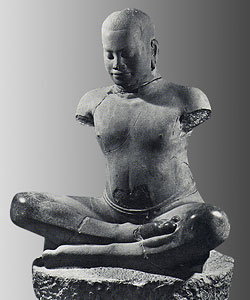
Note that the statue is fragmented in several places. Of the few statues of King Jayavarman VII found their conditions are similarly poor. Only one head of the 3 statues suffered the least damage. (Please click on the picture to see the details). Because of his peaceful expression, wearing bare necessity to meditate, and the lack of evidence of other activities the king might have in his sixties, the common view thought of the king projecting himself as Buddha. However, the king wore a thin mustache above his lip; the usual attire to meditate is the bare minimum; meditation is an activity to maintain a balanced lifestyle. The king looked healthy with a slight belly in his sixties as portrayed to life in this statue. He probably ate meat as part of a healthy diet unlike the svelte, ascetic Buddha on a vegetarian diet. His Buddha representation sat on top on coiled the 7-heads naga, which opened his hood to protect the Buddha. Was Jayavarman VII really as believed in the image of the Buddha? (2012 update: ALL new facts released in book: "The Ancient Secrets of a Royal Triad: DECODED")
the Profile a Dynamic, Chic King · New · Exclusive · 2010
Please click to view on the left: New Insights, and on the right: The Royal Lifestyle in Bayon.
Doing the research on Queen Indradevi and Queen Jayarajadevi, inevitably led to new insights on this royal triad. The last 200 years common views were a handicap to uncover new findings. Therefore, an alternative approach of the current discovery was to start with the facts, gathering of the body of evidence, and letting the details showed a pattern. These new patterns either dismissed or affirmed the common views or formed new hypotheses. As a result, these new findings developed into a fuller profile of the builders, innovators of the Khmer Empire — King Jayavarman VII, Queen Indradevi and Queen Jayarajadevi.
The queens and king revealed to be dynamic and deeply involved in managing their nascent empire. They created new reforms in the social, religious, educational, and political arenas. Their imprints could be felt and seen in the bas reliefs, steles, and monuments they have built from the obvious to the subliminal enigmatic smiles of Bayon. Unlike the sitting, still, homely, and very few images of the king and the queens see for yourself their active, alluring profile in these new, exclusive images of the enterprising, uncommon achievers, standing, riding, walking, kneeling, and leading by examples their countrymen. (Please click on the above and below images to see the details).
Hail to a Fallen Patriot · New · Exclusive · 2010

— he was a son, a husband, a father, a warrior, a ruler of the Khmer empire —
With an open heart and an open mind, Queen Jayarajadevi, Queen Indradevi and King Jayavarman VII applied through their branded religious models many modern concepts. These queens and king were the unsung pioneers of socialism, women's rights, public healthcare, service and education, which they practiced 830 years ago for the benefit of the one million citizens of Angkor as well as for the millions more people throughout in their empire.
![]()
phalikaN - 12 Sept., 2010

